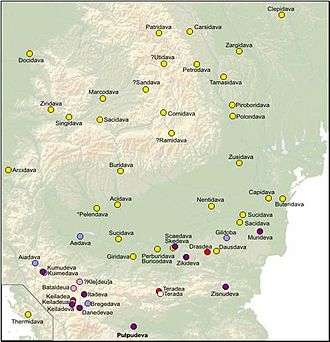Aizis
 Shown within Romania | |
| Alternate name | Aixis, Aixim, Airzis, Azizis, Azisis, Aizisis, Alzisis, Aigis, Aigizidava, Zizis |
|---|---|
| Location | Caraș-Severin, Romania |
| Coordinates | 45°29′16″N 21°50′59″E / 45.4877°N 21.8498°ECoordinates: 45°29′16″N 21°50′59″E / 45.4877°N 21.8498°E |

Aizis (Aixis, Aixim, Airzis, Azizis, Azisis, Aizisis, Alzisis, Aigis, Aigizidava[*], Zizis, Ancient Greek: Αίζισίς) was a Dacian town mentioned by Emperor Trajan in his work Dacica. Located at Dealul Ruieni,[1] Fârliug, Caraș-Severin, Romania.
One sentence surviving from Dacica, in the Latin grammar work of Priscian, Institutiones grammaticae,[2] says: inde Berzobim, deinde Aizi processimus, meaning We then advanced to Berzobim, next to Aizi.[3] The phrase describes the initial itinerary march into Dacia by the Roman army After the Roman conquest of Dacia, a castrum gets built at Aizis.
It is also depicted in the Tabula Peutingeriana, as Azizis, on a Roman road network, between Bersovia and Caput Bubali.
Etymology
The place name Aizizi, located in the South West of Dacia has a root / radical containing the Bactrian "ait", Armenian “iz” ‘snake’ or better the Bactrian "azi" Armenian "ajts" 'goat'.[4] The Romanian historian and archaeologist Vasile Pârvan also gives the meaning 'goat'.[5]
This Dacian name (mentioned also by Ptolemy as Αίζισίς) confirms the Dacian language change from Proto-Indo-European *g to z: Αίζισίς (Ptolemy) < *aig-is(yo) – ‘(place) with goats’ (Greek αίζ, αίγός goat) [6]
See also
Notes
- ↑ Monografia localității Fârliug by Pr. Cristian Franț
- ↑ Priscian & 520, VI 13.
- ↑ Exploratio: Military and Political Intelligence in the Roman World from the Second Punic War to the Battle of Adrianople by N. J. E. Austin, N. B. Rankov Routledge, 1995, ISBN 0415049458, ISBN 9780415049450
- ↑ “Les restes de la langue dace” by W. Tomaschek (Gratz University) in “Le Museon (Revue Internationale Volume 2)”, Louvain, 1883 (page 402)
- ↑ Pârvan 1982, p. 165.
- ↑ E.C. Polome “Chapter 20e Balkan Languages (Illyrian, Thracian and Daco-Moesian)” in The Cambridge Ancient History, edited by John Boardman, 2nd Edition, Volume 3, Part 1, The Prehistory of the Balkans, the Middle East and the Aegean World, Tenth to Eighth Centuries BC, ISBN 978-0-521-22496-3, page 887
References
Ancient
- Priscian (ca. 520 AD). Institutiones grammaticae (in Latin). Check date values in:
|date=(help)
Modern
- Pârvan, Vasile (1982). Florescu, Radu, ed. Getica (in Romanian). București, Romania: Editura Meridiane.
External links
| Wikimedia Commons has media related to Dacia and Dacians. |
- Traiani Augusti, Dacica at Forum Romanum
- Monografia localității Fârliug by Pr. Cristian Franț
- Fârliug in Enciclopedia Banatului
